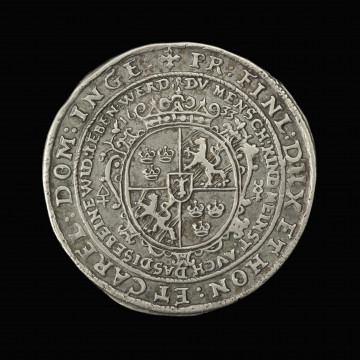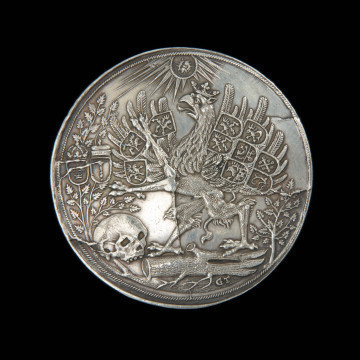
1/4 of a thaler in memoriam of Gustav Adolf
1633
National Museum in Szczecin
Part of the collection: Pomeranian coins
Commemorative coins were introduced in West Pomerania in the first half of the 17th century. They were often produced to commemorate the death of dukes and members of their families. They were generally not intended for regular circulation but were distributed as a tribute to their predecessors, raising the prestige of the ruler and the state. In such circumstances, there was usually little time for original symbolism, so specific iconographic patterns and motifs recur. Most often, a bust of the deceased and a multiple-line legend, like an obituary, informing of the reason for minting, the dates of birth and death, and the founder of the issue. The coin presented here refers to the end and funeral of Prince Francis in 1620. At the Szczecin mint, his successor, younger brother Bogusliw XIV commissioned the minting of thalers, their fractions and multiples commemorating this event. The high denominations coins had the same traditional arrangement - a bust of a duke and a inscription. The quarter thalers featured a new design with prominent symbols and attributes of death - a skull and a scythe. Coins of lower denominations were distributed or even tossed among the crowd gathered in the streets. At the same time, a multiple of the silver thaler or gold ducat was given to important personalities during celebrations. The coin came from the 19th-century Pomeranian Karl Ludwig Grabow (1790-1859) collection and was acquired for the National Museum in Szczecin in 2013. Genowefa Horoszko
Other names
Reichsort o. J. (1620) auf den Tod Herzogs Franz
Author / creator
Object type
1/4 of a thaler
Technique
coining
Material
silver
Origin / acquisition method
purchase
Creation time / dating
Creation / finding place
Owner
Muzeum Narodowe w Szczecinie
Identification number
Location / status

1633
National Museum in Szczecin

1654
National Museum in Szczecin

1654
National Museum in Szczecin
DISCOVER this TOPIC
National Museum in Lublin
DISCOVER this PATH
Educational path